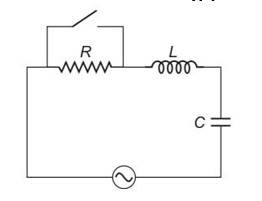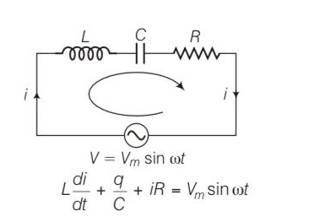Alternating Current
Get insights from 92 questions on Alternating Current, answered by students, alumni, and experts. You may also ask and answer any question you like about Alternating Current
Follow Ask QuestionQuestions
Discussions
Active Users
Followers
New answer posted
4 months agoContributor-Level 10
This is a short answer type question as classified in NCERT Exemplar
If we consider a L-C circuit analogous to a harmonically oscillating spring block system. The electrostatic energy CV2 is analogous to potential energy and energy associated with moving charges (current) that is magnetic energy LI2 is analogous to kinetic energy.
New answer posted
4 months agoContributor-Level 10
This is a long answer type question as classified in NCERT Exemplar
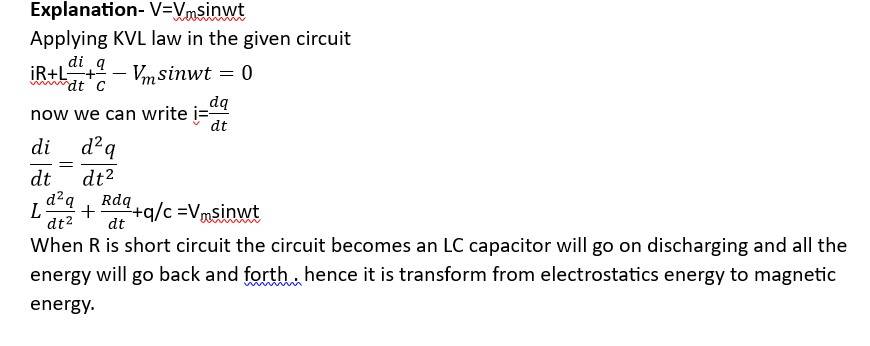
New answer posted
4 months agoContributor-Level 10
This is a long answer type question as classified in NCERT Exemplar
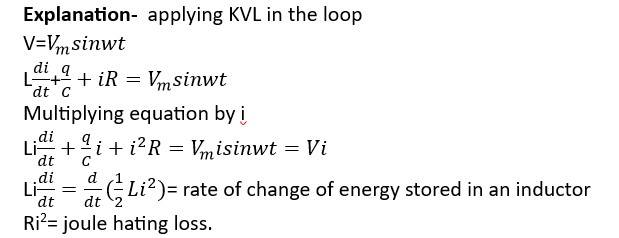
New answer posted
4 months agoContributor-Level 10
This is a long answer type question as classified in NCERT Exemplar
Total current i=i1+i2
Vmsinwt=Ri1
I1=
If q2 is charge on the capacitor at any time t then for series combination of C and L
Applying KVL in below circuit
So q2=qmsin(wt )……….1
qm[ sin(wt+ )]= Vmsinwt
if
qm=
from above equation i2=
i2= when
so total current I = i1+i2
I=
I= i1+i2= Ccos +Csin
I= Csin(wt+ )
C=
1/2
= tan-1
1/2
This is the expression for impedance.2
New answer posted
4 months agoContributor-Level 10
This is a long answer type question as classified in NCERT Exemplar
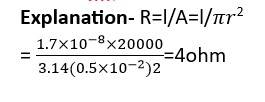
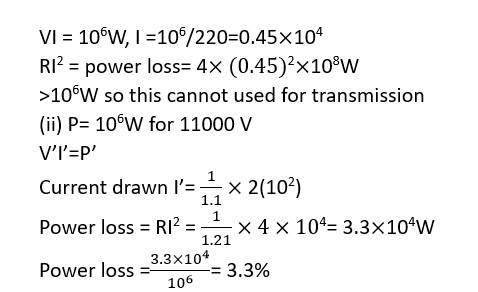
New answer posted
4 months agoContributor-Level 10
This is a long answer type question as classified in NCERT Exemplar
Power drawn, p= 2KW= 2000W
tan =-3/4
P=V2/Z
Z=V2/P= =25
Z =
25=
625 = ………… (1)
tan = = ¾
XL-XC= 3R/4
Use this in eqn 1
625= R2+ (3R/4)2 = R2+9R2/16
625 = 25R2/16, R= 20ohm
XL-XC=15ohm
Im= I= = = 12.6A
If R, XL and Xc are all doubled, tan does not change . Z is doubled, current is halved. So power is also halved.
New answer posted
4 months agoContributor-Level 10
7.26 The rating of step-down transformer = 40000 V – 220 V
Hence, the input voltage, = 40000 V
Output voltage, = 220 V
Total electric power required, P = 800 kW = 800 W
Source potential, V = 220 V
Voltage at which electric plant generates power, V' = 440 V
Distance between the town and power generating station, d = 15 km
Resistance of the two wires lines carrying power = 0.5 Ω /km
Total resistance of the wire, R = 2 = 15 Ω
rms current in the wire lines is given as
I = = = 20 A
Line power loss = = 15 = 6 W = 6 kW
Since the leakage power loss is
New answer posted
4 months agoContributor-Level 10
7.25 Total electric power required, P = 800 kW = 800 W
Supply voltage, V = 220 V
Electric plant generating voltage, V' = 440 V
Distance between the town and power generating station, d = 15 km
Resistance of the two wires lines carrying power = 0.5 Ω /km
Total resistance of the wire, R = 2 = 15 Ω
Step-down transformer rating 4000 – 220 V, hence
Input voltage to the transformer, = 4000 V
Output voltage from the transformer, = 220 V
rms current in the wire lines is given as
I = = = 200 A
Line power loss = = 15 = 600 W = 600 kW
Since the leakage po
New answer posted
4 months agoContributor-Level 10
7.24 Height of the water pressure head, h = 300 m
Volume of water flow rate, V = 100 /s
Efficiency of turbine generator, = 60 % = 0.6
Acceleration due to gravity, g = 9.8 m/
Density of water, = kg/
Therefore, electric power available from the plant =
= 0.6
= 176.4 W
= 176.4 MW
New answer posted
4 months agoContributor-Level 10
7.23 Input voltage, = 2300 V
Number of turns in primary coil, = 4000
Output voltage, = 230 V
Number of turns in secondary coil =
From the relation of voltage and number of turns, we get
= or = = 400
Hence, there are 400 turns in the second winding.
Taking an Exam? Selecting a College?
Get authentic answers from experts, students and alumni that you won't find anywhere else
Sign Up on ShikshaOn Shiksha, get access to
- 65k Colleges
- 1.2k Exams
- 687k Reviews
- 1800k Answers

